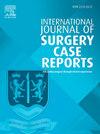并发胰腺导管腺癌和低分化神经内分泌癌:1例报告及文献复习
IF 0.7
Q4 SURGERY
引用次数: 0
摘要
摘要胰导管腺癌(PDAC)合并低分化神经内分泌癌(NEC)是一种罕见的疾病。由于每种癌症的独特特征和治疗方案,这种同时发生的情况给诊断和治疗带来了重大挑战。准确的诊断对于优化治疗结果和预后至关重要。我们报告一个55岁男性2型糖尿病合并银屑病关节炎的病例,在检查时发现血清CA 19-9水平升高。影像学检查,包括CT和EUS,显示胰腺头部有一个6厘米的肿块。eus引导活检证实PDAC。惠普尔手术后,病理显示同时低分化NEC伴30%神经内分泌成分。手术后,患者接受了以吉西他滨为基础的化疗,术后6个月无疾病。本病例说明了同时PDAC和低分化NEC的诊断复杂性。在这种情况下,有效的管理得益于外科医生、肿瘤学家和病理学家之间的合作。由于记录在案的病例数量有限,没有足够的证据来告知最佳治疗策略,特别是关于最有效的化疗选择。本病例增加了越来越多的关于罕见并发胰腺肿瘤的文献,并强调了进一步研究以加强理解和制定全面临床指南的必要性。结论PDAC联合低分化NEC对诊断和治疗提出了独特的挑战。该病例强调了多学科方法的重要性,并呼吁进一步研究以制定针对这些罕见恶性肿瘤的循证管理方案。本文章由计算机程序翻译,如有差异,请以英文原文为准。
Concurrent pancreatic ductal adenocarcinoma and poorly differentiated neuroendocrine carcinoma: A case report and review of the literature
Introduction
Concurrent pancreatic ductal adenocarcinoma (PDAC) and poorly differentiated neuroendocrine carcinoma (NEC) is a rare condition. This simultaneous occurrence poses significant diagnostic and therapeutic challenges due to the unique characteristics and treatment protocols of each cancer. An accurate diagnosis is crucial to optimizing treatment outcomes and prognosis.
Presentation of case
We present a case of a 55-year-old male with type 2 diabetes and psoriatic arthritis, referred for an elevated serum CA 19–9 level found during a check-up. Imaging studies, including CT and EUS, revealed a 6 cm mass in the pancreatic head. EUS-guided biopsy confirmed PDAC. After a Whipple procedure, pathology showed concurrent poorly differentiated NEC with a 30 % neuroendocrine component. After surgery, the patient received gemcitabine-based chemotherapy and was disease-free at six months post-surgery.
Discussion
This case illustrates the diagnostic intricacy of simultaneous PDAC and poorly differentiated NEC. Effective management in such scenarios benefits from a collaborative approach among surgeons, oncologists, and pathologists. Due to the limited number of documented cases, there is insufficient evidence to inform the best treatment strategies, particularly concerning the most effective chemotherapy options. This case adds to the growing body of literature on rare concurrent pancreatic tumors and highlights the need for further research to enhance understanding and develop comprehensive clinical guidelines.
Conclusion
The combination of PDAC and poorly differentiated NEC poses unique diagnostic and treatment challenges. This case underscores the importance of a multidisciplinary approach and calls for further research to develop evidence-based management protocols for these rare malignancies.
求助全文
通过发布文献求助,成功后即可免费获取论文全文。
去求助
来源期刊
CiteScore
1.10
自引率
0.00%
发文量
1116
审稿时长
46 days

 求助内容:
求助内容: 应助结果提醒方式:
应助结果提醒方式:


